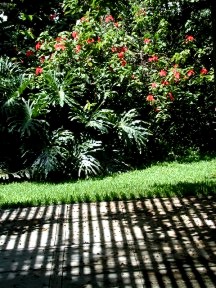High noon outside the dining area
A Modest Tropical Garden
by Derek Burch
My small garden in Fort Lauderdale, Florida, started out as a garden that would not suffer from a few weeks or even months of neglect (do as I say, not as I do, applies here).
It was not ever intended to be a native plant habitat, since I am far too fond of colorful and interesting plants from other areas to submit to the tyranny of accepting or rejecting plants on the basis of where they originated. How could I, a Brit in a strange land, be comfortable with that xenophobic approach to the place in which I spend time every day!
The lot was quite open when we moved into the house in 1979, but with a dominating Ficus benjamina that threatened to engulf the back garden, and two Araucaria heterophylla that towered over everything in the front. These were marked for early removal: as much as I hate to take out a tree, they were not only out of scale, but could have been a threat to the house in a bad storm.
The trees that would remain were a large mango with an interesting branch structure, and several citrus, planted, as you might expect, in a line at the edge of the property. What I wanted made up a fairly simple list: screening on all sides, a variety of fruit trees, very little grass and a forested feeling. We had just returned from five years in Puerto Rico, living for half that time on the edge of the wet forest on the hills around El Yunque, so a tropical ambiance was very much part of the plan. One of the reasons to moving to Puerto Rico in the first place had been the wish to grow plants that found the Tampa Bay area of Florida too cold.
The garden pretty much planned
itself. Wide planted areas on three sides in the back, with a number of
slender-trunked palm trees to give the impression of height to the canopy,
and whatever layers of tree, shrubs and smaller plants I could shoehorn
in. Paths winding through these planted beds to allow a closer look at
the smaller plants day by day. We left some grass, but covered most with
a large paved terrace under a slatted overhead to give plenty of sitting
room outside French doors from the dining area. We put a raised hot tub
to one side of the paved deck. Land is too expensive in Florida not to
take advantage of every square foot as a living area.
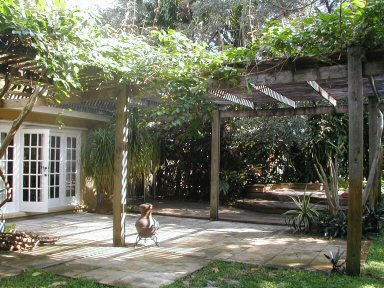 |
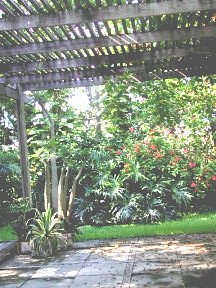 |
|
|
The patio with the hot tub and
raised deck
|
Shade -at a more reasonable
time of day to sit outside |
|
The front garden was largely
taken up by a semicircular drive and entry into the carport, but had space
for several flowering trees, tied together with more planting beds, crammed,
of course, with shrubs and smaller plants. The street (a cul-de-sac) is
pretty well hidden from the house.
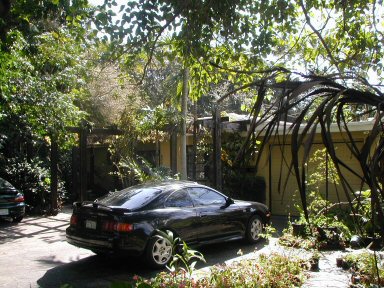 |
|
|
The front of the house
|
Looking towards the street
|
Well,
it has been more than 20 years since the first plant went in the ground.
It is like many other gardened gardens - I responded to the need for shade,
but could not call a halt as the trees grew more and more exuberantly.
I ran out of space many years ago in spite of losing trees which gave
me some temporary room again for a while. This is very much the cycle
of tropical forests: dense growth, then a tree falls, opening up space
for sun-loving pioneers, which are all too soon shaded out as the trees
grow to fill the overhead.
| I lost six palm trees to a single lightning strike at one point, and once the dead trunks came out, and I had stopped mourning, I realised that I had a glorious light spot to put in some things that could not take shade. I still have this space, and have become more aggressive in controlling the trees around it, so I have room for some of my gingers that had only existed in pots until this point. |
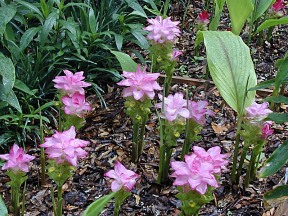 |
|
Curcuma elata, a springtime
delight
|
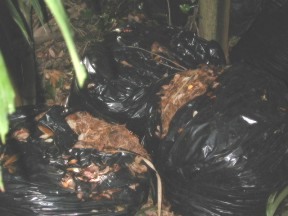 |
I don't fertilise on any sort of schedule, but I do haul in all the leaves and grass cuttings that I can, and mulch all the junk mail that floods in every day. I dare say that I am breaking all manner of municipal rules, but so far so good. One thing, that I already knew intellectually, has become very real in this garden. One of my trees, a carambola or star fruit (Averrhoa carambola) has a severe micronutrient deficiency - something odd about my soil. |
|
Brown gold - leaves from the
neighbourhood
|
I have treated with micronutrient mixes with little result, and have had no success with many cumulative feet of surface mulching - here is the lesson in common sense - how could I get additional micronutrient from the mulch when it is derived from the deficient soil. I understand this, but it still seems unfair, since I firmly believe that mulch cures just about everything that could possibly ail a garden just by bringing the soil to life. All those teeming microorganisms have got to solve lots of problems.
On to spring images
The picture of Curcuma elata is from Dave Skinner's garden, Le Jardin Ombrage, and I thank him for permission to use it. His site http://www.nettally.com/skinnerd/gingers.htm http://www.nettally.com/skinnerd/gingers.htm has loads of ginger pictures and is a great source.
